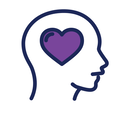Let’s start off on the right foot
“The earth is what we all have in common.” —Wendell Berry

The skinny
Recent study reveals that providing certain mental health benefits and promoting them to targeted populations is an opportunity to demonstrate empathy to key demographics, while the most popular benefits are now table stakes.
♥
Tell me more.
We all know that many employees have struggled with mental health recently and the HR community has long known about the impact of mental health on worker productivity, disability, absenteeism, and presenteeism.
Yes, old news.
Well, here’s some new news for you. Not only was focusing on mental health in 2020 good for the bottom line, but for many employers, their response to mental health needs was viewed as a sincere and direct expression of workplace empathy.
Ok, great?
Truly. Before the dark days, mental health benefits were seen as the whipped cream on top of a sundae. A really great way to round out the ice cream treat and make it extra special, but if left off, well, you still have three scoops of ice cream and maybe some hot fudge. Now, mental health benefits have become ice cream scoops in the sundae. In other words, essential.
That’s real scoop.
Indeed. But the issue is communication. Many employees remain unaware of employer benefits to support mental health, and few are reaching out for help at work.
But we have an open-door policy?
Great start. However, the negative stigma that surrounds mental health struggles is still haunting the place. In fact, 64% of employees say that reaching out to HR or management about a mental health issue would negatively impact their job security.
Need a stigma ghostbuster.
That wouldn’t be strange to have in the neighborhood. Now let’s get into those benefits. The ones that are #winning across the board are flexible work hours, being encouraged to take breaks, open-door policies, and the one with the highest marks was mental health vacation days.
Mental health days?
Exactly. Mental health days are a perfect way to bust that stigma ghost by normalizing and encouraging taking time off to care for mental health. Another benefit that ranked high for Latinx employees was onsite mental health care specialists and wellness workshops that focus on physical and mental health. For Black employees, 93% prefer coverage options for mental health services through the employee benefits enrollment process.
Further listening: Mental health awareness webinar.
Date with data: 41% of Americans over the age of 18 struggled with mental health and substance abuse.
Double date: Employers lose $44 billion per year in productivity loss due to depression alone.
The skinny
Research reveals 96% of HR leaders report they are increasingly concerned about employee well-being in a hybrid work model.
♥
Hybrid?
Sure. Hybrid is the future. Only 1% of HR leaders in a recent survey said they expect all of their employees to work full time in the office once the pandemic ends. Hybrid work, which was once a unicorn-dragon-fairy-rainbow-pot-of-gold benefit is now a must-have for organizations.
So, why the concern?
Emerging research exploring the differences between onsite and hybrid environments uncovers that several features native to the hybrid environment are driving employee fatigue and putting employee well-being at risk.
Like what?
There are three key factors to keep in mind: digital distractions, virtual overload, and the struggle to disconnect from work.
This sounds like a whole lotta burnout.
You’re skating on the right track. Employees who experience a high level of digital distractions are 1.32 times more likely to feel emotionally drained from their work. Plus, employers may be doing more harm than good. Research shows that employers feel they need to compensate a hybrid model with more virtual meetings. This is actually having the opposite effect.
Video fatigue?
Right again. HR leaders agree, 76% said the increase in the number of virtual touchpoints employees face puts them at risk for burnout.
Lights are always on.
When you’re always on, you lose. Working remotely makes it more difficult to set clear boundaries between work and life due to the absence of signals that tell us when to start and stop work. 40% of hybrid or remote employees report an increase in the length of their workday in the past 12 months.
I’m fatigued.
Time for some adjustments. This is new territory, and many organizations are trying really hard, but actually exacerbating workplace fatigue. First, stop micromanaging and “big-brother-ing”—many employees are worried about their organizations monitoring them and therefore don’t “turn off.” HR leaders need to start evaluating how to minimize exposure to digital distractions, and how to mitigate risks of virtual overload. It’s a delicate balance between building a digital culture while also encouraging teamwork and protecting employees’ mental well-being. This is truly a new trail to blaze.
Further reading: Are you a hybrid workforce champion or a laggard?
Date with data: 90% of organizations believe that flexibility is helpful for women’s professional development, especially working mothers.
Totes quotes: “A hybrid work model that takes advantage of the flexibility and freedom of remote work and the collaborative nature of office work will provide employees with the best of both worlds. This work arrangement allows employees to divide their time between home-based tasks, which are independent and require more focus, and office-based projects, which are more collaborative.” —Ronni Zehavi, CEO of Hibob
Tools: Returning to work survey.
The skinny
There is a phycological reason for feeling "blah."
♥
Do tell.
Well first let me ask you: Do you find yourself rewatching The Mummy with Brendan Fraser for the 100th time? Having trouble concentrating? Lying in bed past your usual wake time playing Words with Friends?
Yes, but I still have energy, too.
Right. You just feel somewhat joyless and aimless?
Freaky right?
Well, my friend, you are suffering from the “blahs” or, more specifically, you are languishing.
What’s that?
Languishing is a sense of stagnation and emptiness. It kind of feels like you’re walking through metaphorical mud or looking at the world through dirty sunglasses.
Blah.
Yeah. We’ve talked about this before. But, basically in 2021 we were all in flight/fight mode as we developed certain routines to help ease our sense of dread. Now, that anguish has given way to chronic languish, which is basically the neglected middle child of mental health, in between flourishing and depression. It’s the absence of well-being.
Deep.
It’s more tippy-toe water level. You don’t have symptoms of mental illness but you’re not the picture of mental health either. Languishing dulls your motivation, disrupts your ability to focus and triples the odds that you’ll cut back on work. It appears to be more common than major depression too.
I’m indifferent.
That’s another symptom. Part of the danger of languishing is you might not realize the dulling of delight, the dwindling of drive or the slow slipping into silence and solitude. When you can’t see your own suffering or realize something is wrong, you can’t get help.
O__o
Here’s some good news. Psychologists find that one of the biggest strategies for managing emotions is to name them. Just like we all collectively identified “grief” as the sponsor for 2020, now we can use that same lesson here to help us crystallize and name the new sponsored emotion for 2021. Hey, you’re not alone; languishing (just like grief) is common and shared.
Totes quotes: “Learned a very relatable term today: “報復性熬夜” (revenge bedtime procrastination), a phenomenon in which people who don’t have much control over their daytime life refuse to sleep early in order to regain some sense of freedom during late night hours.” —Daphne K. Lee
Antidote for languishing: Flow. Or state of absorption in a meaningful challenge or momentary bond where your sense of time, place, and self-melts away. So, don’t feel bad for bingeing your favorite show and staying up a little past your bedtime sometimes. That’s a way you’re flowing and connecting to something outside yourself.
 Now a break from the news… |
Compliance Corner |
Here’s something to…
- Watch: Celebrate Earth Day with these documentaries.
- Read: Is improved financial wellness the COVID-19 silver lining?
- Breathe: 4 breathwork exercises that experts say ease stress.
- Review: Still weighing vaccine incentives?
- Eat: How to eat less meat. For a greener time!
|

Benefits Insight Dashboard
Find out if your employees are risk takers.
|
|



